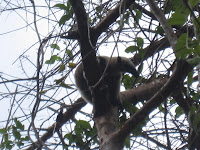Captain's Blog: Aruba to Bonaire
Well, hurricane season in Aruba somehow turned into a full-time position at the International School of Aruba for me and a part-time position and internship for Sam. We both accomplished our goals – letters of recommendation and experience.
We made plans to head north to the DR, up through Turks & Caicos, and finally to Florida, where permits and the like are not issues. We assembled a crew consisting of three of my close Dutch friends for the first leg to the DR – the rest would be day trips that Sam and I could handle on our own.
But while working at ISA, we got to know someone who accepted a position as head of school at an international school in Sint Maarten. And it just so happened that he needed a college counselor and “right-hand man” (or, in this case, woman).
We were flown to Sint Maarten, toured the school, and signed contracts in a whirlwind of a week.
Sint Maarten is the boating capital of the northern Caribbean. You can see St. Barts, Saba, and Anguilla on a foggy day – and many more islands are easy day trips. The Caribbean chandleries (marine hardware stores) all base their operations out of SXM because it is a truly duty-free port – no import taxes whatsoever. Aruba was over 20%. And there are 10 marinas to choose from in SXM, as opposed to Aruba’s two.
It’s also smack in the middle of the hurricane belt, but you can’t have everything, right?
So, new plan: first to Bonaire (I had always wanted to go, and it allows a boat to avoid the weather that comes out of the Atlantic through the Mona Passage), then north to Puerto Rico, through the BVI’s and USVI’s, and finally Sint Maarten. After checking immigration laws, I learned that the Dutch crew would need actual visas for the trip – the visa waiver program for EU citizens only applies when travelling by commercial vessel, be it a cruise ship or an airplane. To travel on a private vessel such as H2 would involve them making appointments for interviews at a US consulate or embassy. This is a three month process – and Aruba has no such facility, so they would have to fly to Venezuela or Curacao to do it.
New plan again: we’d go to Bonaire, then go straight up to Sint Maarten. But I did the math and realized that it would only save five hours if we went to Bonaire first – and the trip to Bonaire would take 20. And there was a nice weather window a week away . . .
New plan again: Aruba to Sint Maarten, no stops. But it’s a long trip (3+ days), and we weren’t comfortable doing it with inexperienced crew. We called Jeff, who was able to alter his busy schedule of boat drinks and hitting on women half his age to accommodate our crew needs. Oh, and he’d recently finished is USCG captain’s license course.
The band was getting back together. Sam booked his flight before he had a chance to back out.
One by one, the Dutchies all backed out. I was a little disappointed at first, my 10 hours off two hours on watch schedule slowly turning in to four hours off two hours on, but we didn’t want anyone on board who wasn’t comfortable, and, as Jeff pointed out, we wouldn’t have had 10 hours off – someone would have to stay up and make sure the Dutchies were actually standing their watches.
It turned out that this was definitely for the best for everyone – most definitely.
Our crew of three set out for SXM on Monday – Easter Monday in Aruba. I pulled up to the customs dock (empty!), checked us out, and we were off.
But we forgot one key preparation. We didn’t blast “I’m on a Boat” as we left port.
Everything was going fine, we rounded the southern coast of Aruba and took the turn to the north. The autopilot didn’t want to follow the chartplotter, but it would still hold a magnetic course, so it wasn’t a big deal.
And then Jeff asked, “Do you hear that?” Sam and I both immediately said yes – a squeal coming from the engine room. He opened up an aft hatch, and told me to slow it down and put her in neutral.
It was the transmission. Again.
The paint was blistering off of it - it was that hot. Over 300 degrees Fahrenheit – the max recommended temp is 190, and the “shut it down now!” temp is 230.
And it wouldn’t go back in to forward. It would go in to reverse, oddly, but a single-engine boat like H2 doesn’t go straight in reverse – you can’t get anywhere that way.
We were about a mile off the coast, completely exposed to whatever the Mona was throwing down out of the Atlantic. Simply put, it was rough. The decision was made to contact the Ports Authority for a tow. They contacted search and rescue to send out a boat to tow us in. Of course, they had to assemble their team, and decide on a boat – standard Aruba stuff. After an hour, they told us it would be two more hours until they could get there.
Sam positioned herself on the starboard side, removing the contents of her stomach. Jeff took over at the helm. I went to the aft deck for a cigar.
Somehow, Jeff got the transmission to kick in gear after an hour. I contacted search and rescue, who still wanted to help - an offer I accepted.
They didn’t tell me they’d contacted the local newspapers and radio stations, public relations being as important as anything else apparently. We made at least one paper, a great shot from the guy’s camera phone.
They escorted us to the customs dock (I requested that we be allowed to check in by car due to being under duress, but no such luck – Aruba loves their rules, the less logical, the better). We got back in our slip, and started investigating.
Transmission fluid covered the bilge, making it look like a murder scene (transmission fluid is dyed red so that you know what it is). Since it had been running at over 300 degrees, it all would have to be replaced.
The next day, we did all that we could think of. Fortunately, I had both the “users manual” (read: worthless) and shop manual (read: reality). We changed the oil, inspected the control valve assembly . . .
Oh, the control valve assembly. This is what enables a boat to go in to forward, neutral, and reverse. It also determines when there is enough pressure to put the transmission oil in to the intercooler – preventing overheating.
H2 had, from the day we bought her, an issue getting out of forward and in to reverse. This is a MASSIVE issue when you’re pulling up to a fuel dock, the end of which is taken up by a 4+ million dollar superyacht. Reverse is very important in such situations.
My Aruba mechanic had recently figured out that this control valve assembly was what was making it so difficult to get in gear. However, we fixed it with less-than-idea equipment – a shop vice, hammer, and flat-blade screw driver.
Jeff and I (read: jeff) pulled it apart, and discovered that it wasn’t functioning perfectly. We (read: he) put it back in, and we did a “dock test” – we ran her at 1500 RPMs in the dock and watched what happened.
We still got up to 240 degrees, but we knew that she would stabilize at 220-something if we left it under 1200 RPM.
New plan: we would head to Bonaire as a sea trial. If anything went wrong, we’d be within 20 miles of shore.
Honestly, we needed to get off the island. We had already sold our car, Sam and I were ready to go, and Jeff . . . Jeff didn’t like Aruba very much.
We left on Thursday. We had to leave Thursday – you can’t leave on a Friday (because Titanic left on a Friday) and, ironically, a Friday departure would have been the 100 year anniversary of Titanic’s maiden voyage. Oh, and did I mention that it was Friday the 13th as well?
We were going Thursday.
Back to the customs dock – a very different experience when the holiday weekend was over. It was stacked 3-deep with day-traders, pangas, etc. This was the dock I had run the H2 aground on approach to Aruba.
I decided to not risk that again – I’d dock behind the tankers, where the waters were 12 feet deep, not six.
As soon as we’d tied up, we were told that we couldn’t tie up there. After some argument, I gave up, and we maneuvered our way past the pangas, day traders, on to the dock – in six feet of water (H2 draws 5 feet).
I cleared us out, again (they remembered me, and had kept my paperwork).
Off to Bonaire.
I had always wanted to go to Bonaire. And it would make a very necessary “sea trial”.
The transmission ran hot the entire time – 220-230 – but it was stable, so we were okay with it. We made 4.5 knots – a slow slog.
Curacao was beautiful at night.
About half way through, I noticed that the shower sump light (light that indicates the shower pump is on) was staying on. And, stupidly, I didn’t bother to check why – I mentioned it to Jeff, and he recommended turning it off at the breaker, logically assuming I had checked the actual pump first.
Four hours later . . . I don’t recall the actual sequence of events. All I know for sure is that I heard Sam and Jeff talking about water appearing in the companionway (that I had blamed on Monty’s bladder, of course), and I immediately remembered the shower pump situation.
I pulled the floorboard in the forward stateroom (where the shower pump is located), and it was flooded.
FLOODED.
Bring on the bucket brigade.
We were able to bail it out eventually. Apparently Sam and Jeff were able to have a better sense of humor about it than I was, but that’s another story.
Otherwise, the trip went smoothly. It was great to be out at sea again.


Thanks for the posts on your "Adventure." Hopefully the trip on to Sint Maarten will be less eventful, problem-wise. We are looking forward to hearing about your new resident location.
ReplyDelete